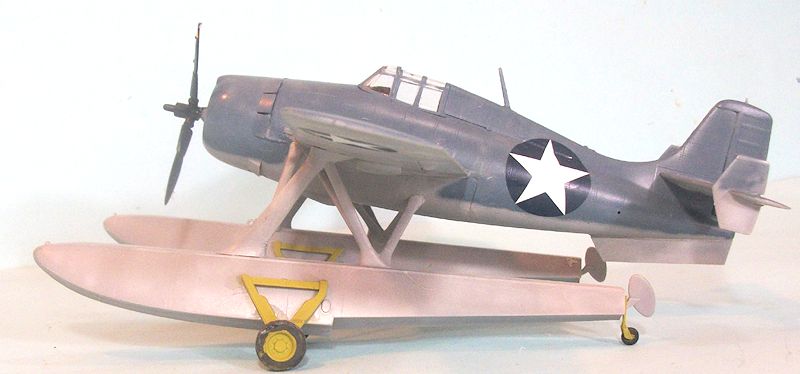
Hobby Boss 1/48 F4F-3S Wildcatfish
| KIT #: | 81729 |
| PRICE: | 5200 yen at HLJ |
| DECALS: | One option |
| REVIEWER: | Tom Cleaver |
| NOTES: |

| HISTORY |
Before the war, the Imperial Japanese Navy wasn’t the only one
concerned about the provision of air power in an island campaign across the
Pacific. The U.S. Navy was also
well aware that between the time the troops stormed ashore and the time an
airfield could be constructed, the limited number of aircraft carriers could
not remain in the vicinity of the invasion as targets for enemy ships,
aircraft and submarines.
Fortunately for the American Navy, the solution to this problem would come
by the militarization of American industrial construction methods, which led
the world for ability to handle large
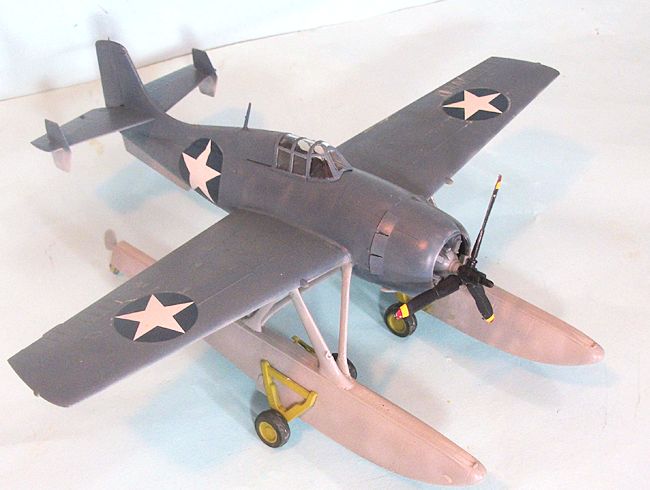 projects
at a high rate of construction.
Japanese military officers after the war would state that the American
ability to quickly construct airfields and port facilities was the major
reason why they lost the Solomons, where they were not able to complete one
new airfield in total during the entire campaign up to the capture of
Bougainville in October 1943.
projects
at a high rate of construction.
Japanese military officers after the war would state that the American
ability to quickly construct airfields and port facilities was the major
reason why they lost the Solomons, where they were not able to complete one
new airfield in total during the entire campaign up to the capture of
Bougainville in October 1943.
In
late 1941, however, this was all in the future, and the Navy was gravely
concerned with the problem of air cover following invasion.
Like the Japanese naval air force, the Bureau of Aeronautics decided
that a floatplane fighter would be the solution.
While the Japanese at first commissioned a designed‑for‑the‑purpose
fighter ‑ the N1K1 Kyofu (Rex) ‑ and then later adapted the Zero as the
A6M2‑N when the development of the N1K1 slowed, the U.S. Navy decided to
adapt an existing fighter from the outset.
In
early 1942, the Edo Corporation was contracted to convert one F3F‑3 to a
floatplane configuration as the F4F‑3S.
Unlike most Navy floatplanes, this did not have a centerline float
and two wingtip floats ‑ as did the A6M2‑N ‑ but was equipped with twin main
floats. Faced with a need for such an airplane, the Navy proceeded to change
a contract for 100 F4F‑7 long‑range recon Wildcats with Grumman to an
additional 100 F4F‑3s.
By the time the F4F‑3S flew on February 28, 1943, the Navy’s SeaBee construction battalions had proved their worth, and the program was canceled. The conversion took three months to complete. Initial flight tests revealed directional instability that resulted in the addition of a substantial ventral fin in addition to the smaller fins on the horizontal stabilizers. Top speed was reduced to 254 m.p.h., which was considered barely acceptable. The 100 F4F‑3s on the production line were finished as land planes during early 1943 ‑ the last Wildcats built by Grumman ‑ and assigned to Training Command. This would prove fortunate for history, as the three F4F‑3s ditched in Lake Michigan during the war and later recovered in the 1980s were from this batch, and now constitute the only three early Wildcats still in existence.
| THE KIT |
Over the years, modelers have been intrigued by the Wildcatfish.
During the 1970s at least two adventurous souls I knew took the
Monogram Wildcat, a pair of Monogram Kingfishers, added quite a bit of
scratchbuilding ability, and kitbashed Wildcatfish models.
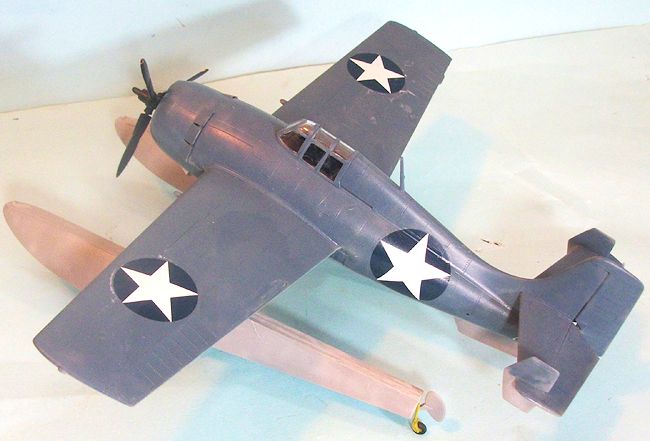 Back in 2001, Cutting Edge released a pricy conversion set to be used
with the Tamiya F4F‑4, with two large resin floats and resin fins and rudders,
and white metal struts and beaching gear.
This still required the modeler to convert the folding‑wing F4F‑4 to a
stiff‑wing F4F‑3, which involved filling in the fold line and the outer gun bay
in each wing, sanding those areas smooth and then rescribing all the engraved
detail. Outside of one guy I know
here in Southern California, wildcat‑loving modelers took a pass on the project
at t hat point.
Back in 2001, Cutting Edge released a pricy conversion set to be used
with the Tamiya F4F‑4, with two large resin floats and resin fins and rudders,
and white metal struts and beaching gear.
This still required the modeler to convert the folding‑wing F4F‑4 to a
stiff‑wing F4F‑3, which involved filling in the fold line and the outer gun bay
in each wing, sanding those areas smooth and then rescribing all the engraved
detail. Outside of one guy I know
here in Southern California, wildcat‑loving modelers took a pass on the project
at t hat point.
In 2002,
Dave Schemel created an F4F‑3 conversion set for the Tamiya Wildcat, that
completely replaced the wing sub‑assembly of the kit with a one‑piece resin
wing. This made a Wildcatfish
project much easier.
Needless
to say, at a cost of $26.00 for the Tamiya Kit, $50.00 for the Cutting Edge
conversion and $40.00 for the Just Plane Stuff wing conversion, a modeler has to
be extremely interested in the F4F‑3S to step up to this project.
Now that both The Cutting Edge conversion and the wing conversion sets
are long out of production, with collector’s prices approaching a few hundred
dollars in total, such a project is impossible for all but the most committed
modelers.
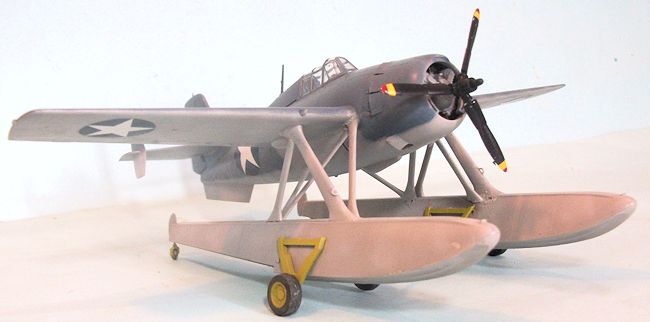 Fortunately, Hobby Boss has come to the rescue.
I for one never thought I would see the F4F-3S done as a kit from a major
mainstream manufacturer, but as the list of aircraft already out as models has
increased, a company like Hobby Boss needs to look further and further afield
for new products. This has resulted
in good kits of the Focke-Wulf Ta-152C, of which perhaps five ever flew, and the
BV-141B, of which even fewer ever flew.
Thus, it’s not so surprising that the company would turn to a one-off
prototype, particularly when they have already done a normal F4F-3, which cuts a
considerable bit off of design costs for such a product.
At a price of around $45, which is what I saw two going for at the LHS
recently, this is a very reasonably-priced project.
Fortunately, Hobby Boss has come to the rescue.
I for one never thought I would see the F4F-3S done as a kit from a major
mainstream manufacturer, but as the list of aircraft already out as models has
increased, a company like Hobby Boss needs to look further and further afield
for new products. This has resulted
in good kits of the Focke-Wulf Ta-152C, of which perhaps five ever flew, and the
BV-141B, of which even fewer ever flew.
Thus, it’s not so surprising that the company would turn to a one-off
prototype, particularly when they have already done a normal F4F-3, which cuts a
considerable bit off of design costs for such a product.
At a price of around $45, which is what I saw two going for at the LHS
recently, this is a very reasonably-priced project.
The kit provides an F4F-3 kit, with a fuselage sprue that has the wheel
wells filled in, and a set of floats and struts on another sprue.
Decals are provided to do the one and only F4F-3S.
| CONSTRUCTION |
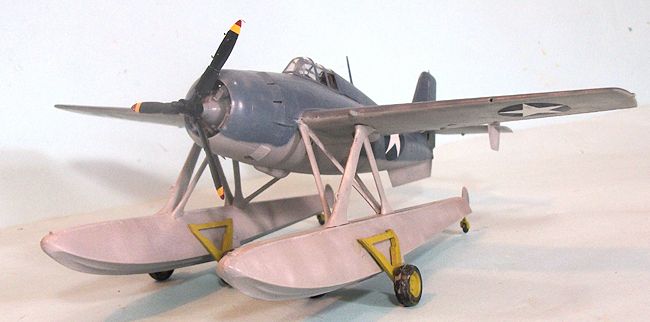
Without an open wheel well, it isn’t necessary to use the detail parts
for the rear of the engine, since that won’t be seen.
Assembly of the airframe is simple, and took only a few hours to
complete.
Unlike the Cutting Edge conversion, which has parts that don’t really fit
together, the floats and struts provided here fit the way they should, and once
each float and its associated struts is assembled, they attach to the wings and
fuselage without problem.
| COLORS & MARKINGS |
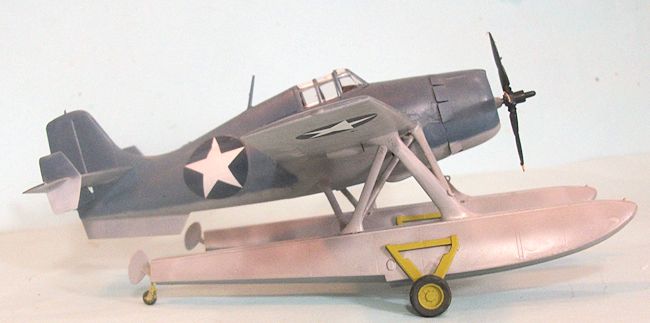
| CONCLUSIONS |
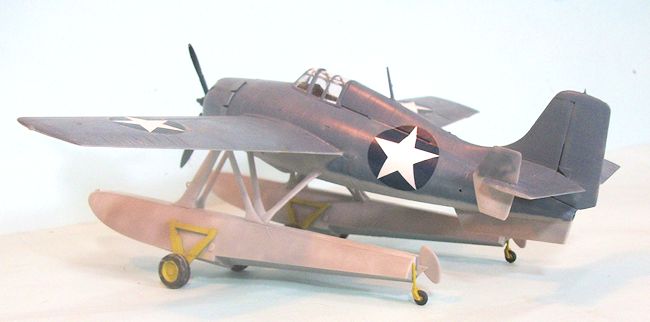 Like I said, I never expected to see this Wildcat sub-type appear as a
mainstream injection-molded kit.
Hobby Boss has done a good job here in presenting this rare and
highly-interesting subject, which presents absolutely no problems in assembly.
Any modeler with a few kits completed should have no difficulty at all
with this kit. A modeler interested
in “what if” models could have a lot of fun making the floatplane fighter that
never went to war with this kit.
Highly recommended.
Like I said, I never expected to see this Wildcat sub-type appear as a
mainstream injection-molded kit.
Hobby Boss has done a good job here in presenting this rare and
highly-interesting subject, which presents absolutely no problems in assembly.
Any modeler with a few kits completed should have no difficulty at all
with this kit. A modeler interested
in “what if” models could have a lot of fun making the floatplane fighter that
never went to war with this kit.
Highly recommended.
December 2014
Review kit courtesy of HobbyLink Japan. Order yours here.